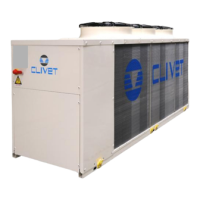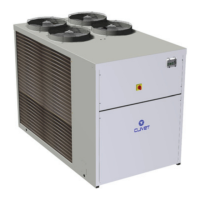Do you have a question about the CLIVET WSAT-XEE 222 and is the answer not in the manual?
Unique machine identifier for tracing specific features and components.
Lists typical reasons for unit malfunction or unexpected shutdown.
Specifies the unit's designed purpose and crucial safety precautions.
Identifies hazardous areas around the unit and risks during handling operations.
Highlights potential dangers and safety requirements for the unit's electrical system.
Warns about injuries from moving parts and hazards of refrigerant exposure.
Recommendations for secure unit installation, anti-vibration devices, and windbreaks.
Essential electrical data, safety, and connection procedures for the unit.
Essential checks for installation, power supply, and system readiness.
Verifying electrical connections, tensions, and compressor crankcase heaters.
How set-point compensations affect compressor activation and system performance.
Procedures for safely resetting alarms and identifying their root causes.
Differentiating between pre-alarms, signals, and faults for proper response.
How to view and interpret the unit's alarm log, including flashing codes and timestamps.
Guidelines for periodic inspections, manufacturer instructions, and CE PED directive.
Diagnosing issues related to high/low pressure, faulty probes, and transducers.
Troubleshooting pressure transducers and identifying refrigerant circuit faults.
Identifying and resolving protection faults for compressors, fans, and pumps.
Unique machine identifier for tracing specific features and components.
Lists typical reasons for unit malfunction or unexpected shutdown.
Specifies the unit's designed purpose and crucial safety precautions.
Identifies hazardous areas around the unit and risks during handling operations.
Highlights potential dangers and safety requirements for the unit's electrical system.
Warns about injuries from moving parts and hazards of refrigerant exposure.
Recommendations for secure unit installation, anti-vibration devices, and windbreaks.
Essential electrical data, safety, and connection procedures for the unit.
Essential checks for installation, power supply, and system readiness.
Verifying electrical connections, tensions, and compressor crankcase heaters.
How set-point compensations affect compressor activation and system performance.
Procedures for safely resetting alarms and identifying their root causes.
Differentiating between pre-alarms, signals, and faults for proper response.
How to view and interpret the unit's alarm log, including flashing codes and timestamps.
Guidelines for periodic inspections, manufacturer instructions, and CE PED directive.
Diagnosing issues related to high/low pressure, faulty probes, and transducers.
Troubleshooting pressure transducers and identifying refrigerant circuit faults.
Identifying and resolving protection faults for compressors, fans, and pumps.











